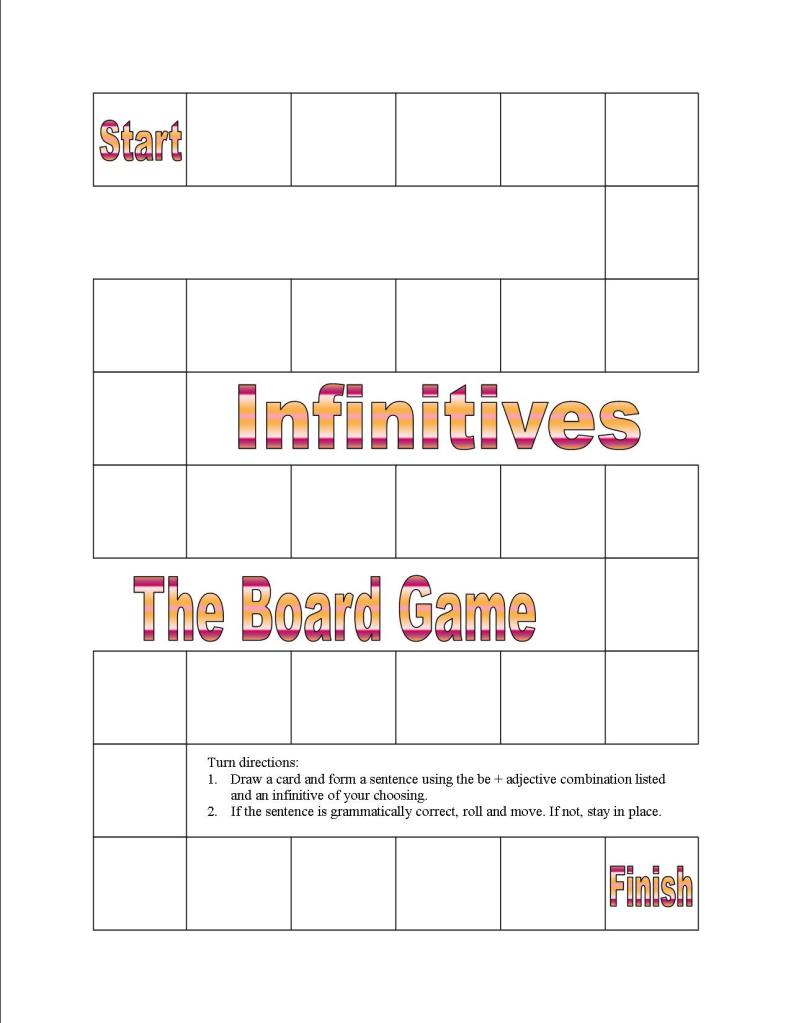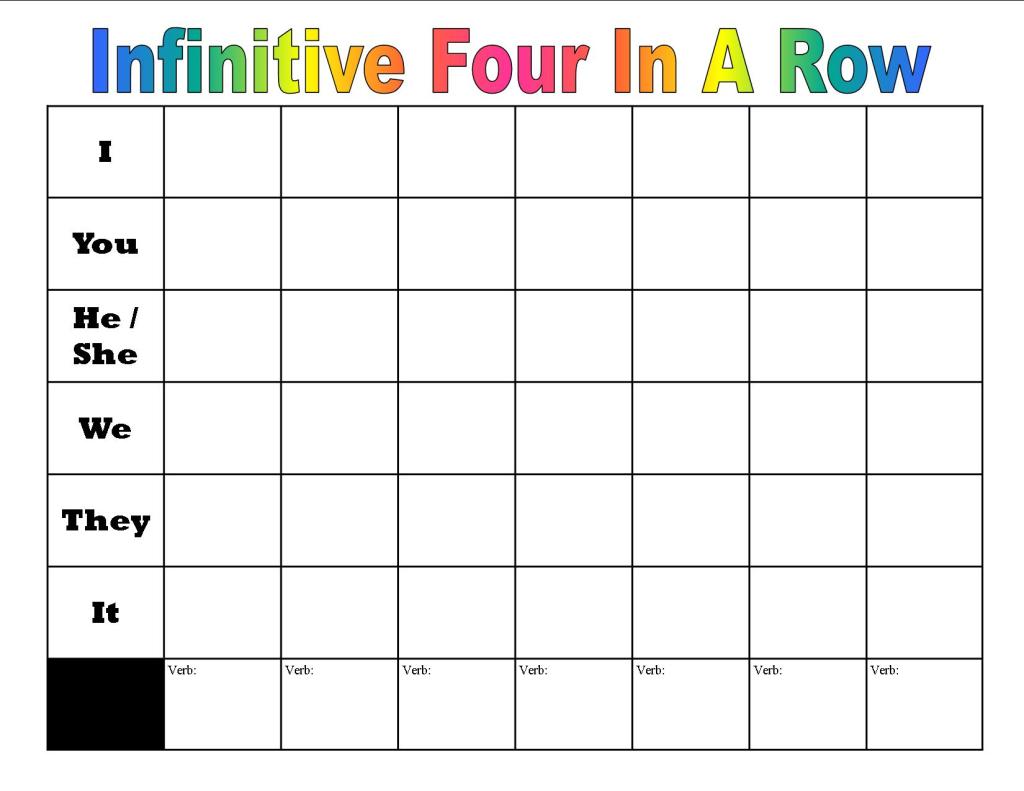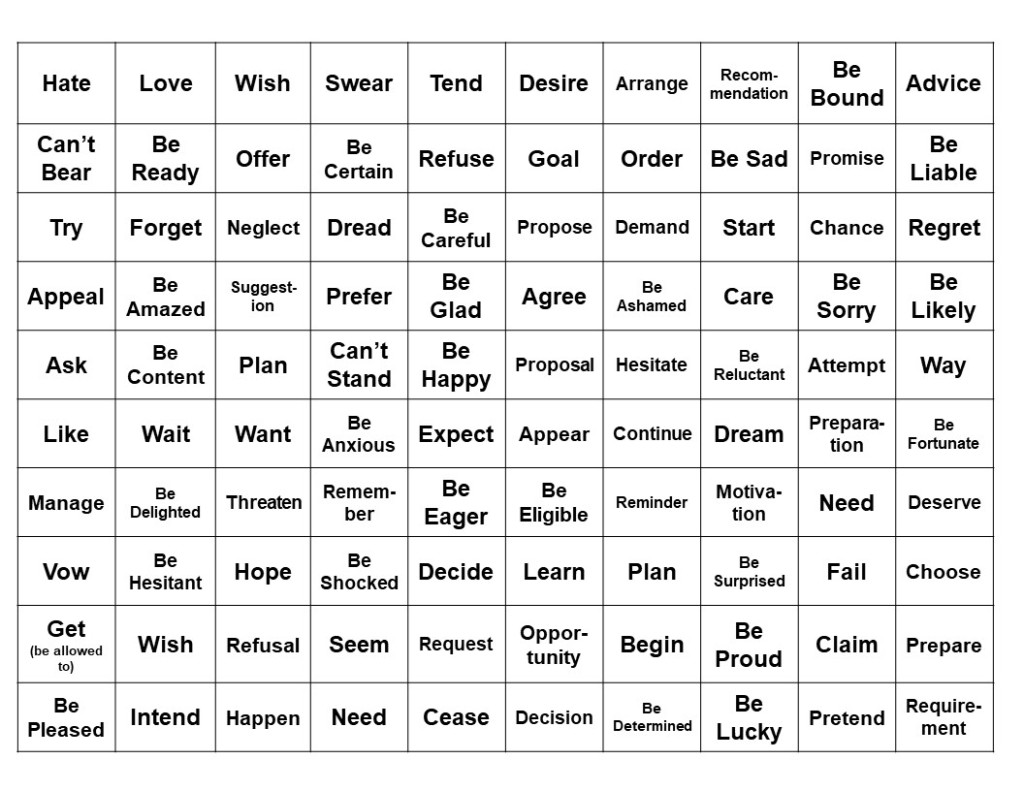I’ve seen a lot of funny memes about infinitives, such as “To infinitive and beyond!” and “To infinitive or not to infinitive, that is the question.” And while they make me smile, they don’t always cause my students to smile. Another thing that doesn’t cause them to smile is most infinitive practice activities, which is why I created four of my own games. I won’t guarantee your students will love infinitive practice with them, but I will guarantee they are more fun than another worksheet!
Infinitives The Board Game
Infinitives: The Board Game allows students to practice forming sentences using be+adjetive combinations and infinitives. After we discuss the format and look over a list of the most common be+adjective combinations followed by infinitives, we practice making our own sentences. The game uses my zig-zag board (free download below the picture) and has cards with twenty-five different be+adjective combinations.
On a turn, the active player will draw a card and form a sentence with the be+adjective combination and an infinitive of his/her choosing. For example, a player might draw “be anxious” and give the sentence, “I am anxious to visit Italy someday.” If the sentence is grammatically correct, the player rolls the number cube and moves his/her piece. The first player to reach the finish square is the winner.
Infinitive Cover Up Game
Cover Up games are hugely popular with my students, and Infintivie Cover Up is no different. This particular infinitive game focuses on noun + infinitive combinations. Each square of the board has a noun that can be followed by an infinitive. In order to cover the square, the student must form a sentence of his/her own choosing using the given noun and an infinitive.
As with all Cover Up games, the boards can be used in two different ways, complete cover (students each have their own boards and try to be the first to cover all the squares) or cover the most (two students share a board and try to have the most covers on the board by the end of the game). This particular game includes a split-board version for the complete cover version of the game. The split-board version has two boards on one page to reduce paper use when printing.
In order to gain the right to cover a square, a student rolls a twelve-sided die (or two six-sided dice), finds the square with the same number, and checks to see if it is covered or not. If the square is not covered, the student states a sentence with the given noun and an infinitive. (“The student’s plan to complete his homework on Friday was a good one.”) If the sentence is grammatically correct, the student covers the square. Popular covers in my class include milk jug lids, mini-erasers, plastic chips, or using a dry erase marker on a laminated board.
Infinitive Four In A Row
Another game that I have quite a few versions of is Four In A Row (context clues, verb tenses, modal verbs, adverbs of manner, and vowel sounds). This game plays like the classic children’s game, Connect Four, and is another common one in my classes (you can download a copy of the basic game board we use under the picture). This version, Infinitive Four in a Row, asks students to elicit free-form sentences using infinitives and pronouns. The game board has pronouns on the verticle axis, and students fill in the horizontal axis boxes by drawing verbs that are commonly followed by infinitives from a set of 52 cards.
On a student’s turn, he/she will decide which box he/she would like to try to claim and then form a sentence using the corresponding verb and pronoun with an infinitive of the student’s choosing. (“She would like to go to Rome someday.”) If the sentence is grammatically correct, the student claims the box by using a cover (the same things we use when we play Cover Up). The first student to cover four squares in formation is the winner.
Escape! The Infinitive Grid
I have several Escape! games (irregular verbs, irregular plural nouns, question words), and they have become quite popular with my students. Escape! The Infinitive Grid is no exception, and the goal is the same as the previous versions of the game: move from one side of the board to the other by forming sentences using the target grammar or vocabulary. This particular version targets forming sentences using infinitives that commonly follow verbs, nouns, and be+adjective combinations. It’s a free download below the picture and is a great way to review infinitives.
Conclusion
We don’t always use all four of these games when we practice infinitives in my classes, but we generally play at least one. My students have enjoyed being able to practice using infinitives without having to complete another worksheet. Besides being available as individual downloads, there is a bundle of all four games available, too. Happy teaching, everyone!




